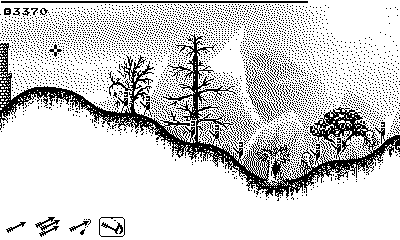The Long Arc
The Long Arc takes “tower defense” literally – you’re actually defending your tower from hordes of attacking enemies. The gameplay is a bit like Worms, where you’ll aim parabolic shots from a set point. The set point is your tower, and soldiers will continue to march on you level after level. When they reach you, they’ll start chopping away at your wall until they break it down and you have to restart.
It’s got some roguelike to it, too: in between each level, you can spend some of the points you’ve earned (you’ll earn extra if you maintain a no-miss combo or shoot enemies in the head vs. the knees) on one weapon or tower upgrade per level. In this respect, it reminded me a bit of recent Playdate gem Armada, but that one was set in space and had lasers and aliens instead of gravity, a bow and arrow, and shambling zombie soldiers.
You’ll advance to the next tower each level, with a small bit of self-dialogue to get a little of the not-entirely-spelled-out-for-you story. This mixes up the landscape to make it harder to hit enemies, and there’s an increasing variety of them as you go through the game. There is an ending, but it’s tough! I made it about halfway through, and I’m not sure I have the gumption to make it past that. Starting again from scratch and making better upgrade choices between levels might be in order, but I did make it to fifth place on the leaderboards! Since you have to spend points to get better upgrades, it’s possible to drop down the rankings, too, since the best power-ups are the most expensive.
Since you have to nock your arrow in between every shot, it can get stressful as you see a line of creatures approaching you. However, it does a good job of balancing things so you can juuuuust make it through. The sense of relief you get when they stop advancing and that upgrade screen appears is comparable to finally beating a Silksong boss that you’ve been bumping into for an hour.
It’s not the most complicated game on paper, but there are a lot of different ways to play it and replay it again. There are a few different control styles, too, and I had a lot easier time using the crank to aim vs. pulling it back and firing. But it’s a lot like driving a manual transmission – if you can figure it out, you’ll be able to get a lot more out of your engine.
If you like tower defense, or Worms, or bow and arrow physics, or interesting Playdate control schemes, or roguelike upgrade systems in between deliberately paced and carefully designed levels, you’ll find something to like here. It’s a good challenge, and it really feels like your own fault when things fall apart. But there’s always a chance to try again.
(Released December 30, 2024, on Itch and July 8, 2025, on Catalog. Copy provided by developer.)
